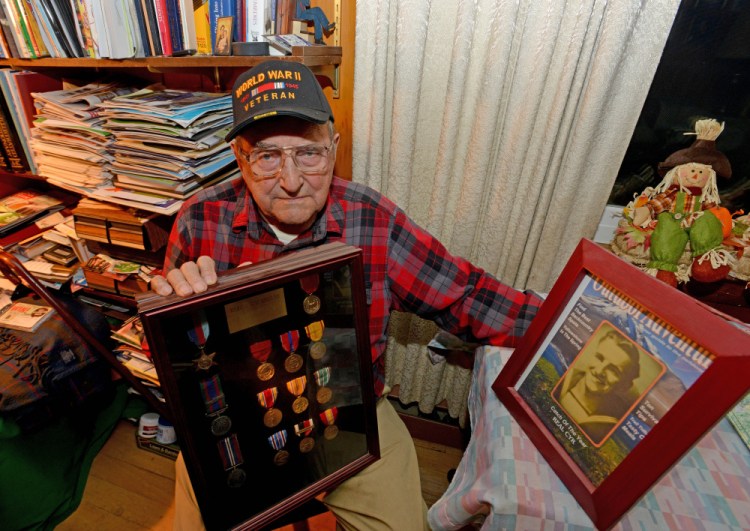There’s not much Real Cyr doesn’t remember about being in the Royal Canadian Navy in World War II.
He was on a submarine off Norway in 1943 and at 4 a.m., he got into a rubber boat with some men and equipment and found a German battleship hiding in the waters. A fight ensued both on and beneath the water.
“Only three of us made it out of six,” Cyr recalled. “The Germans brought us ashore, and they gave us a beating right off. They threw us in an old shed on the beach in Norway. They put us on a train to Oslo, nine hours through tunnels and under mountains. In Oslo, a Gestapo officer met us and put German Army uniforms on us. We marched in German handcuffs. We didn’t march the right way so they put us on a fishing boat for three weeks at sea in the pump room chained to a pipe, and we got bread and water.”
Cyr, now 90, of Winslow, was a young man then, strong and energetic. And he was smart.
When the fishing boat pulled into the Netherlands, the Germans put him and the other men on a train with four armed guards and handcuffed them. One guard spoke English, and Cyr and the other prisoners took advantage of that fact.
“We fooled them. We said, ‘You guys have guns; we are in chains and handcuffs. Take these handcuffs off.’ They finally took the handcuffs off, and one of my buddies used to be a stunt man in the circus and could pass out for no reason, and you couldn’t find a pulse and he’d have blood coming out of his mouth. When he passed out, I asked the guard who spoke English that he must have water. He said, ‘Follow me.'”
Cyr threw his buddy over his shoulder, and with one guard in front of them and one behind, they went into a bathroom and shut the door.
“I let my buddy go, and we took care of those guards,” Cyr said.
More Germans arrived, but Cyr and his two fellow commandos won the fight as the train was slowing down — in France.
They jumped off the train and, still wearing German uniforms, were captured by the Free French. Cyr had a tattoo that said RCNVR, which he said no German would have had, so it saved them.
“That tattoo did quite a bit to prove we were not Germans,” Cyr said. “We spoke French, German and English, and we told them we were German prisoners and they believed us. They put us in a convent, the three of us, and we got dressed like the rest of the nuns. I was assigned to work in the kitchen. They even gave me a name — Mother Emily. I never forgot that name.”
After four days he and his fellow prisoners were given sweaters to wear, pants cut off at the knees and shoes. The shoes did not fit Cyr so he ditched them. They were assigned a man, woman and 13-year-old boy to travel with them at all times as cover.
“We were 22 miles from the ocean. In the daytime we stayed in cellars or on the top of barns. On the third day, we made it to the ocean and it was prearranged with a fishing boat captain. The boat was loaded with herring. We rendezvoused with a British submarine about four hours later, and they took us into London. We went into the hospital and got patched up. The old Queen of England came to visit us and gave us all meritorious medals.”
It was late in 1943 by then. The man in the bed next to Cyr was from Montreal, and he had lost both legs.
Cyr spent a month in the hospital and then was put on a ship to Australia.
“I picked up another submarine, the USS Croaker. All World War II submarines were named after fish and a croaker is a small fish. It’s now in Buffalo, New York, in a museum.”
One night, the USS Croaker was near a Japanese cruiser with three destroyers, and the Croaker went down close to the bottom of the ocean, nearly lying on it. For seven long hours, the Japanese did not detect the Croaker’s whereabouts.
“It rattled us, but it didn’t do too much damage. When it was over, the captain said, ‘Let’s get out of here.'”
Cyr, who had grown up in Maria, Quebec, had entered the Royal Canadian Navy in 1941. Before that, he was in the Canadian Army and had gone through basic and advanced training, but when it came time to prove his age, he was discharged because it was discovered he was not yet 17.
He became a seaman in the Navy. He trained in Quebec City for two weeks and boarded a ship in Halifax and went onto convoy duty.
Eventually he went to England, but the journey was not a good one.
“Being a little Frenchman on the ship, I got all the bad jobs — dirty jobs. They played tricks on me. I didn’t speak English, so I couldn’t defend myself.”
Once in England, a Scottish officer came aboard and asked if anyone was interested in joining the commandos — the British Combined Naval Forces.
“Right away, my arm went up,” Cyr said. “My commanding officer said, ‘Go ahead,’ so I got some more training — 18 more weeks of it. Then I got on a submarine.”
Being able to speak French helped Cyr because when they were off the coast of Africa and messages came in in French, he was able to translate them when others could not.
Cyr became part of the crew of the British submarine HMS Seraph just before he was captured by the Germans off Norway.
When he got out of the service in December 1945, he went home to Canada. There was no work there, but his mother had two sisters living in Waterville, Maine, and they sponsored him to come to the U.S.
“In those days, you had to have a sponsor and a job to come here,” he said.
He landed a job at Hollingsworth & Whitney, the paper company in Winslow that in 1954 became Scott Paper Co. He worked 42 years as an electrician there.
In 1951, he met Theresa Julia on a blind date at the American Legion Hall on College Avenue in Waterville, where Guy Lombardo, the famous band leader and violinist, was performing. He and Julia didn’t see each other for a couple of months after that, but ran into each other at a restaurant and hotel on Temple Street. He drove her home. In 1951, they were married.
“I had a brand new car. It was so cold — 29 below that morning — it wouldn’t start,” Cyr recalled. “My brother-in-law pushed me about three miles before that Pontiac started.”
The Cyrs had five children — Richard, Jeanne, Susan, Victoria and Andrew — who all live in Maine and visit their parents often. Cyr says he is in good shape.
“I have little creaks here and there, but overall, I’m pretty healthy. I still drive my car and make a garden. I’m proud of all my kids, my wife. They all got a degree but me.”
In January, he and his wife will have been married 65 years.
Cyr and other World War II veterans took a trip to Washington, D.C., in June where, as Cyr said, they saw more in one day than most people would see in a week.
“No matter where we went, people all over the place were clapping for you,” he said.
On Wednesday, Veterans Day, Cyr will travel to Portland with the USS Maine Base, a group of veterans who served on submarines. Cyr is one of only three World War II veterans in that group. They will be in the 10 a.m. parade in Portland.
“After the parade, we’re going to the hospital for the kids that got cancer. We’ll go visit them and we give them each a cap. The boys and girls get different colors. We make them honorary service.”
While the war was a long time ago, Cyr remembers it as if it were yesterday, and the memories come back often.
“I haven’t forgotten anything. Some nights, I still dream about it, especially when I was a prisoner. But I never went to prison camp. I was on my way to a prison camp when we jumped off that train. Good thing we were young and well-trained.”
Amy Calder has been a Morning Sentinel reporter 27 years. Her column appears here Mondays. She may be reached at acalder@centralmaine.com. For previous Reporting Aside columns, go to centralmaine.com.
Copy the Story LinkSend questions/comments to the editors.




Success. Please wait for the page to reload. If the page does not reload within 5 seconds, please refresh the page.
Enter your email and password to access comments.
Hi, to comment on stories you must . This profile is in addition to your subscription and website login.
Already have a commenting profile? .
Invalid username/password.
Please check your email to confirm and complete your registration.
Only subscribers are eligible to post comments. Please subscribe or login first for digital access. Here’s why.
Use the form below to reset your password. When you've submitted your account email, we will send an email with a reset code.